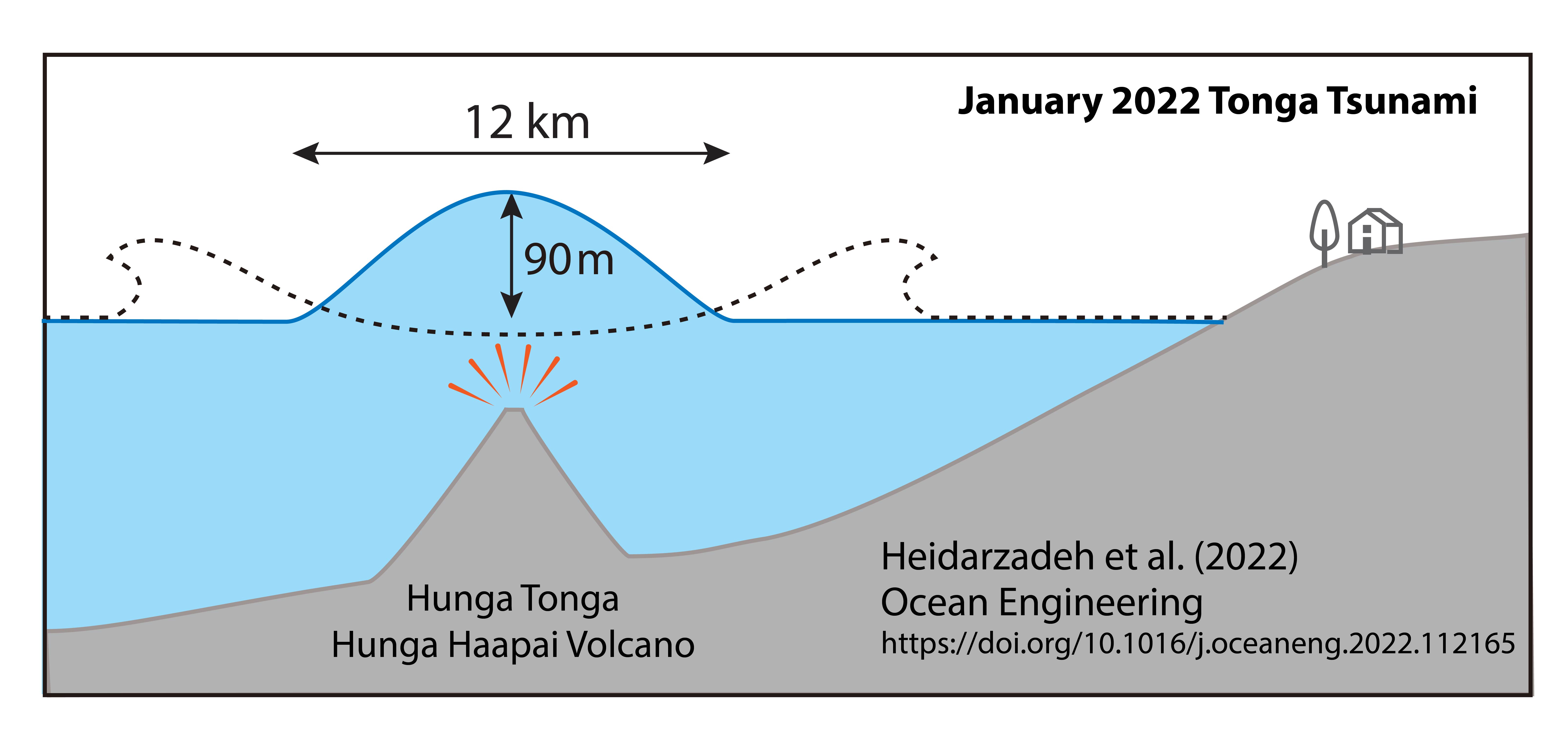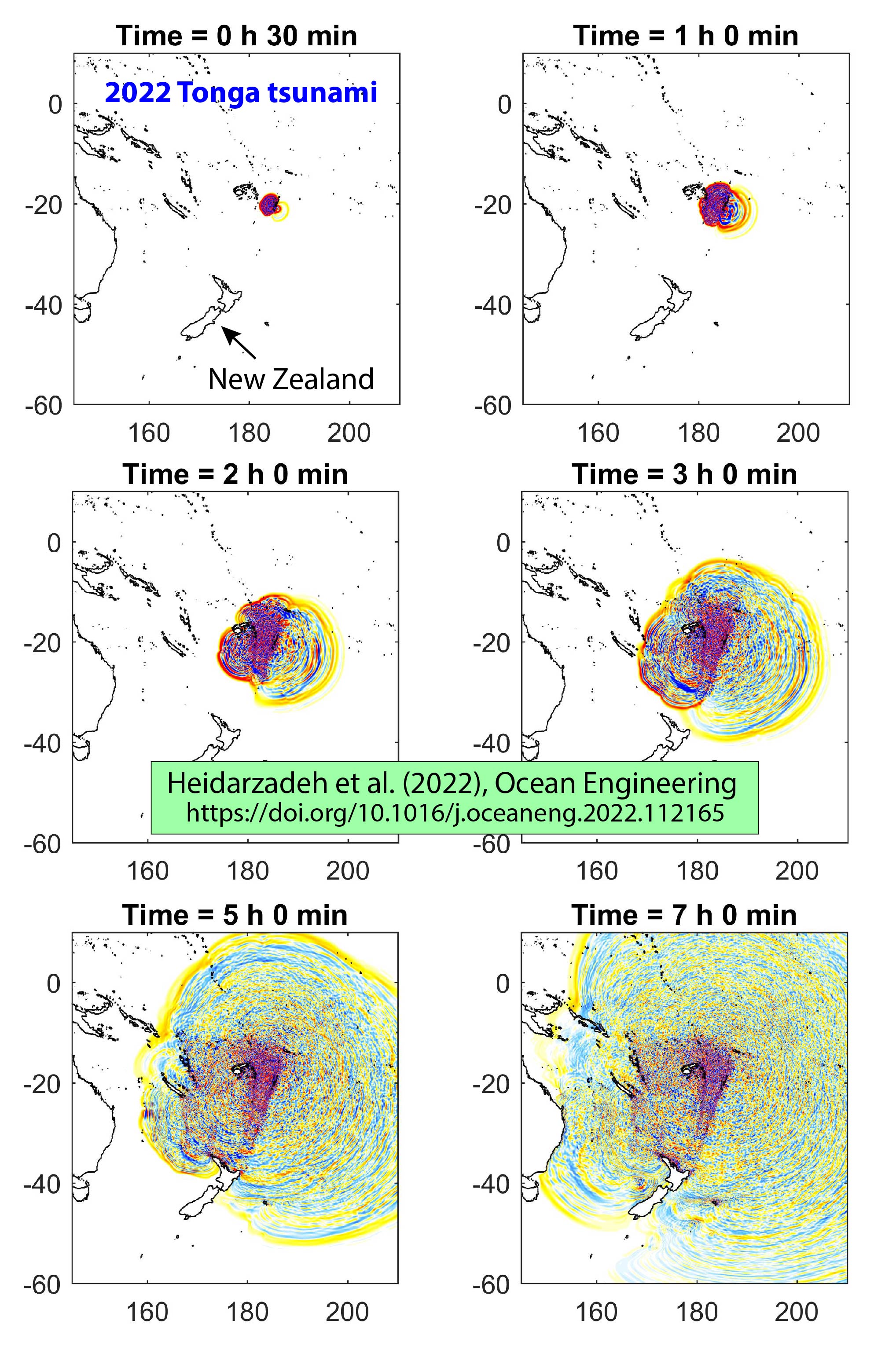By: Dr Mohammad Heidarzadeh
Associate Professor of Civil Engineering at the University of Bath (England)
Secretary General of the International Tsunami Commission.
Email: mhk58@bath.ac.uk
A new study shows that the deadly and global-reaching tsunami generated by the Hunga Tonga–Hunga Haʻapai volcano in January 2022 was as high as 90 m (see Figure 1). The tsunami killed five people and caused large destruction, but it could cause much larger deaths and destruction had the volcano been located closer to human communities. The volcano is located approximately 70 km from Nuku’alofa (the capital city of Tonga); this distance saved Tonga from the 90-m wall of water and significantly minimized its destructive power. See the article here: https://doi.org/10.1016/j.oceaneng.2022.112165

Figure 1: The initial height and dimension of the January 2022 Tonga volcanic tsunami as calculated by Heidarzadeh et al. (2022) (https://doi.org/10.1016/j.oceaneng.2022.112165).
The January 2022 Tonga tsunami was a unique event because the oceanic waves were generated by a dual mechanism comprising water displacement at the volcano and atmospheric pressure waves. Usual tsunamis are generated by displacement of ocean water as a result of seafloor deformation due to an earthquake or a landslide. However, an additional factor contributed to the Tonga tsunami, which was the gigantic atmospheric pressure waves generated by volcanic eruption.
This new study reveals that part of the tsunami generated by the atmospheric pressure waves arrived one to two hours earlier than that generated by water displacement at the volcano. This dual generation mechanism tsunami confused observers and was a challenge for tsunami warning centres because they are programmed based on tsunamis generated by water displacements rather than atmospheric pressure waves. The Tonga tsunami was among the very few tsunamis to be able to travel around the globe (see Figure 2). The tsunami was recorded in all world’s oceans and large seas from Japan and west USA in north Pacific Ocean to the coasts within the Mediterranean Sea. However, the tsunami destruction was limited to the near-field and very little damage were reported in far coasts.

Figure 2: The propagation of the January 2022 Tonga volcanic tsunami across the Pacific Ocean as calculated by Heidarzadeh et al. (2022) (https://doi.org/10.1016/j.oceaneng.2022.112165).
The astonishing wave height of 90 m is far greater than that from the largest tsunamis generated by earthquakes. The March 2011 Japan tsunami due to a magnitude-9.1 earthquake, that killed over 20,000 people, had an initial height of approximately 10 m; however, it was 400 km long, which is much longer than the 12-km length of the 2022 Tonga tsunami (Figure 1).
Tsunamis from volcanic eruptions are characterized by very high wave heights and relatively short lengths as compared to those generated by earthquakes. They can make large destruction along the nearby coasts as observed in January 2022 in Tonga and in December 2018 following the Anak Krakatau eruption. As volcanoes can produce extremely large waves in the nearby coasts (up to 100 m), it is vital that human communities and properties are located at a safe distance from the shoreline.
For more information see the full article:
Heidarzadeh, M.,Gusman, A., Ishibe, T., Sabeti, R., Šepić, J. (2022). Estimating the eruption-induced water displacement source of the 15 January 2022 Tonga volcanic tsunami from tsunami spectra and numerical modelling. Ocean Engineering, 261: 112165. https://doi.org/10.1016/j.oceaneng.2022.112165.